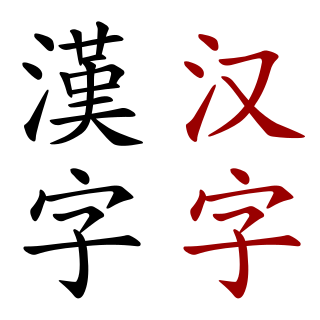
An alphabet is a standardized set of basic written symbols or graphemes that represent the phonemes of certain spoken languages. Not all writing systems represent language in this way; in a syllabary, each character represents a syllable, for instance, and logographic systems use characters to represent words, morphemes, or other semantic units.

Chinese is a group of languages that form the Sinitic branch of the Sino-Tibetan languages, spoken by the ethnic Han Chinese majority and many minority ethnic groups in Greater China. About 1.3 billion people speak a variety of Chinese as their first language.

Korean is an East Asian language spoken by about 80 million people, mainly Korean, as of 2020. It is the official and national language of both North Korea and South Korea, with different standardized official forms used in each country. It is a recognised minority language in the Yanbian Korean Autonomous Prefecture and Changbai Korean Autonomous County of Jilin Province, China. It is also spoken in parts of Sakhalin, Russia and Central Asia.
An orthography is a set of conventions for writing a language, including norms of spelling, hyphenation, capitalization, word breaks, emphasis, and punctuation.

Classical Chinese, also known as Literary Chinese, is the language of the classic literature from the end of the Spring and Autumn period through to the end of the Han dynasty, a written form of Old Chinese. Classical Chinese is a traditional style of written Chinese that evolved from the classical language, making it different from any modern spoken form of Chinese. Literary Chinese was used for almost all formal writing in China until the early 20th century, and also, during various periods, in Japan, Korea and Vietnam. Among Chinese speakers, Literary Chinese has been largely replaced by written vernacular Chinese, a style of writing that is similar to modern spoken Mandarin Chinese, while speakers of non-Chinese languages have largely abandoned Literary Chinese in favor of their respective local vernaculars. Although languages have evolved in unique, different directions from the base of Literary Chinese, many cognates can be still found between these languages that have historically written in Classical Chinese.

Hanja is the Korean name for a traditional writing system consisting mainly of Chinese characters that was incorporated and used since the Gojoseon period (400 BCE). More specifically, it refers to the Chinese characters incorporated into the Korean language with Korean pronunciation.

Man'yōgana is an ancient writing system that employs Chinese characters to represent the Japanese language, and was the first known kana system to be developed as a means to represent the Japanese language phonetically. The date of the earliest usage of this type of kana is not clear, but it was in use since at least the mid-seventh century. The name "man'yōgana" derives from the Man'yōshū, a Japanese poetry anthology from the Nara period written with man'yōgana.

Idu is an archaic writing system that represents the Korean language using hanja. The script, which was developed by Buddhist monks, made it possible to record Korean words through its equivalent meaning or sound in Chinese.

Korean poetry is poetry performed or written in the Korean language or by Korean people. Traditional Korean poetry is often sung in performance. Until the 20th century, much of Korean poetry was written in Hanja and later Hangul.

Korean literature is the body of literature produced by Koreans, mostly in the Korean language and sometimes in Classical Chinese. For much of Korea's 1,500 years of literary history, it was written in Hanja. It is commonly divided into classical and modern periods, although this distinction is sometimes unclear. Korea is home to the world's first metal and copper type, the world's earliest known printed document and the world's first featural script.
Sino-Xenic or Sinoxenic pronunciations are regular systems for reading Chinese characters in Japan, Korea and Vietnam, originating in medieval times and the source of large-scale borrowings of Chinese words into the Japanese, Korean and Vietnamese languages, none of which are genetically related to Chinese. The resulting Sino-Japanese, Sino-Korean and Sino-Vietnamese vocabularies now make up a large part of the lexicons of these languages. The pronunciation systems are used alongside modern varieties of Chinese in historical Chinese phonology, particularly the reconstruction of the sounds of Middle Chinese. Some other languages, such as Hmong–Mien and Kra–Dai languages, also contain large numbers of Chinese loanwords but without the systematic correspondences that characterize Sino-Xenic vocabularies.

Gugyeol, also kwukyel, is a system for rendering texts written in Classical Chinese into understandable Korean. It was chiefly used during the Joseon Dynasty, when readings of the Chinese classics were of paramount social importance. Thus, in gugyeol, the original text in classical Chinese was not modified, and the additional markers were simply inserted between phrases. The Korean reader would then read the parts of the Chinese sentence out of sequence to approximate Korean (SOV) rather than Chinese (SVO) word order. A similar system for reading classical Chinese is used to this day in Japan and is known as kanbun kundoku.
Old Korean is the first historically documented stage of the Korean language, typified by the language of the Unified Silla period (668–935).

Korean mixed script, known in Korean as hanja honyong, Hanja-seokkeosseugi, 'Chinese character mixed usage,' or gukhanmun honyong, 'National (Korean)-Sinic script mixed usage,' is a form of writing the Korean language that uses a mixture of the Korean alphabet or hangul and hanja, the Korean name for Chinese characters. The distribution on how to write words usually follows that all native Korean words, including grammatical endings, particles and honorific markers are generally written in hangul and never in hanja. Sino-Korean vocabulary or hanja-eo, either words borrowed from Chinese or created from Sino-Korean roots, were generally always written in hanja although very rare or complex characters were often substituted with hangul. Although the Korean alphabet was introduced and taught to people beginning in 1446, most literature until the early twentieth century was written in literary Chinese known as hanmun.

The Chinese family of scripts are writing systems descended from the Chinese Oracle Bone Script and used for a variety of languages in East Asia. They include logosyllabic systems such as the Chinese script itself, and adaptations to other languages, such as Kanji (Japanese), Hanja (Korean), Chữ Hán and Chữ Nôm (Vietnamese) and Sawndip (Zhuang). More divergent are Tangut, Khitan large script, and its offspring Jurchen, as well as the Yi script, which were inspired by Chinese although not directly descended from it. The partially deciphered Khitan small script may be another. In addition, various phonetic scripts descend from Chinese characters, of which the best known are the various kana syllabaries, the zhuyin semi-syllabary, nüshu, and some influence on hangul.
The traditional periodization of Korean distinguishes:

A writing system is a method of visually representing verbal communication, based on a script and a set of rules regulating its use. While both writing and speech are useful in conveying messages, writing differs in also being a reliable form of information storage and transfer. Writing systems require shared understanding between writers and readers of the meaning behind the sets of characters that make up a script. Writing is usually recorded onto a durable medium, such as paper or electronic storage, although non-durable methods may also be used, such as writing on a computer display, on a blackboard, in sand, or by skywriting. Reading a text can be accomplished purely in the mind as an internal process, or expressed orally.
Middle Korean is the period in the history of the Korean language succeeding Old Korean and yielding in 1600 to the Modern period. The boundary between the Old and Middle periods is traditionally identified with the establishment of Goryeo in 918, but some scholars have argued for the time of the Mongol invasions of Korea. Middle Korean is often divided into Early and Late periods corresponding to Goryeo and Joseon respectively. It is difficult to extract linguistic information from texts of the Early period, which are written using adaptations of Chinese characters. The situation was transformed in 1446 by the introduction of the Hangul alphabet, so that Late Middle Korean provides the pivotal data for the history of Korean.

Chinese writing, culture and institutions were imported as a whole by Vietnam, Korea, Japan and other neighbouring states over an extended period. Chinese Buddhism spread over East Asia between the 2nd and 5th centuries AD, followed by Confucianism as these countries developed strong central governments modelled on Chinese institutions. In Vietnam and Korea, and for a shorter time in Japan and the Ryukyus, scholar-officials were selected using examinations on the Confucian classics modelled on the Chinese civil service examinations. Shared familiarity with the Chinese classics and Confucian values provided a common framework for intellectuals and ruling elites across the region. All of this was based on the use of Literary Chinese, which became the medium of scholarship and government across the region. Although each of these countries developed vernacular writing systems and used them for popular literature, they continued to use Chinese for all formal writing until it was swept away by rising nationalism around the end of the 19th century.

The Korean alphabet, known as Hangul in South Korea and Chosŏn'gŭl in North Korea, is a writing system for the Korean language created by King Sejong the Great in 1443. The letters for the five basic consonants reflect the shape of the speech organs used to pronounce them, and they are systematically modified to indicate phonetic features; similarly, the vowel letters are systematically modified for related sounds, making Hangul a featural writing system.















